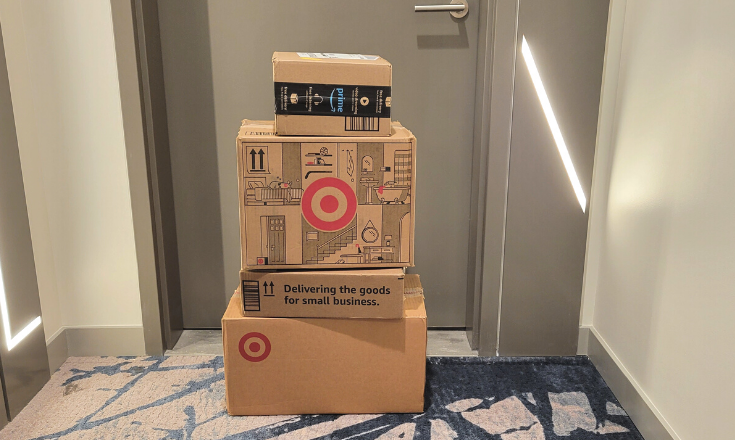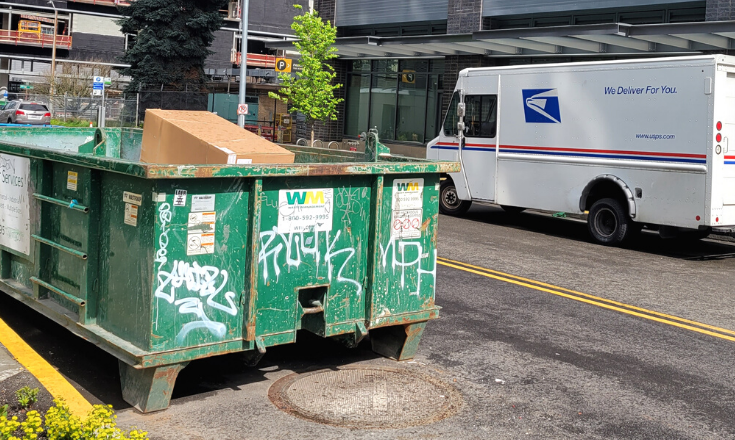After living in the United States for a year, among many other things, I was struck by the number of packages delivered daily to my building and passing through the streets of Seattle. It’s easier to find stacks of boxes on my neighbors’ doors than to see the sunrise. I can’t lie, I also get a lot of boxes. More than I should. I have bought more online here than I have ever in my entire existence.
The isolation imposed by the pandemic increased our complacency. Effortlessly, grocery shopping arrives at our door. Hot food, a new sofa, and shampoo can also arrive in giant packages that would fit personal care products for an entire month. The most essential things in our life don’t fit in boxes; they surround us. Yet, the ease of returning a product, discount coupons, free shipping, and fast delivery are advantages of online shopping in the United States that other countries may not offer.
Vaccinated consumers are returning to stores, and online sales are slowing, but shopping without leaving home will continue to be a routine behavior. According to Digital Commerce 360, e-commerce growth in the United States returned to pre-pandemic levels last year. After growing 31.8% in 2020 (when the pandemic intensified), the highest number since 2012, e-commerce grew by 14.2% in 2021. Enough for boxes to continue being delivered and garbage to continue being produced. This article could be about online shopping, but we need to reinforce the debate about how much waste we produce each day. Are our choices sustainable? How can we be better?
To understand this system and the impacts of my consumerism, I researched some numbers. Surprisingly, Seattle produced less waste at the height of the pandemic (and online shopping) in 2020. According to Seattle Public Utilities (SPU), the overall volume of waste went down in 2020 due to a decrease in commercial waste. In 2019, 757,466 tons of Municipal Solid Waste (MSW) were generated compared to 2020 where 711,619 tons were generated with 54% being recycled. Seven hundred eleven thousand six hundred nineteen tons is equivalent to the weight of 1,459 Boeing Model 747-8 planes. Can you imagine that?
According to data from the 2020 Waste Prevention & Recycling Report, residential waste generation exceeded commercial generation for the first time in 21 years. Residents generated more waste than retail customers. With many people spending more time at home than usual, residential generation rose to over 44% of MSW from 38% pre-COVID-19. There was also an increase in the disposal of Personal Protective Equipment (PPE), such as gloves and masks.
Shopping, packaging, and zero waste
Following the Frontier Group, which produces content on sustainability, more than 28% of all United States waste is containers and packaging. This totals to 82 million tons of material that is commonly thrown away after a product is purchased or used. Mordor Intelligence highlights that the packaging industry in the U.S is expected to grow at a compound annual growth rate of 3.5% in the forecast period from 2021 to 2026. The United States is one of the fastest-growing packaging markets in North America. That’s why it’s difficult to talk about waste without including consumerism and online shopping.

But the truth is that there is much more behind a “simple” purchase. The return of products has generated a silent aggression to the planet. A survey by the National Retail Federation found that across retail, a record $761 billion worth of merchandise was returned last year. A portion of these discards created an estimated 5.8 billion pounds of landfill waste, according to solutions provider Optoro. Amazon, however, has committed to a “zero product disposal goal”. I’m looking forward to it.
I feel a little hopeful when I see that U.S. cities and states and other countries are already moving towards creating zero-waste. Measures include a ban on single-use plastic bags, expanded polystyrene containers, and other single-use packaging. The city of Austin has committed to a zero-waste goal to reduce the amount of trash sent to landfills by 90% by the year 2040.
In January of this year, two new laws entered into force in Washington: “New state law requires food service businesses to make utensils and condiment packages ‘Available Upon Request’ to customers. They can offer items, place items in customer-accessible areas, or provide items upon customer request. They may not place unwanted items in a to-go bag or give them out unrequested. This new law will save restaurants money and eliminate millions of individual items from our overall waste stream over time,” explained Sabrina Register, public information officer for the Seattle Public Utilities.
Register adds that the other new state law bans thin plastic bags and requires an eight-cent fee for large bags. Seattle’s bag ban law has ended, but now the state law is in effect. New features of the state bag law that differs from the Seattle law include a bump in the bag fee up to 8 cents from 5 cents, allowing compostable green carryout bags, and that the rule now applies to restaurants as well. “In the not-too-distant future, consumers will have options to opt for reusable to-go containers. Happening now is an ongoing dialogue between reusable service ware, service providers, and foodservice businesses,” she said.
Sabrina also highlights that SPU continues to improve recycling messages and tools to help customers properly sort any recyclable packaging for online shopping and food delivery such as the Where Does it Go online lookup tool. She also advises: “Buy less, reuse or borrow when possible, and recycle according to our guidelines.”
If you are interested in delving into the subject, you can access web pages such as The Nature Conservancy, which operates in different parts of the world, and read content like Eight Ways to Reduce Waste.
And if you have a shopping site open now on your browser, step back for a moment and think: Do you need to make this purchase? For me personally, I’ve been doing the task of rethinking my purchases. For instance, I donate things I don’t use anymore, and purchase returned items on sale from Amazon. I reuse food containers and separate my organic waste from recyclables. In addition, I keep some boxes so I don’t have to buy them when I need them. I go shopping with backpacks and sustainable bags only. Small actions corroborate for the greater good.
















Be First to Comment